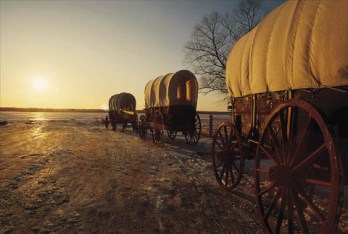Pioneers
Pioneers are generally defined as people who go before and prepare a way for those who follow. By that definition, pioneers may be people who explore space, discover new worlds, or—stretching the definition-- develop new vaccines. However, most Americans think of pioneers as the people who explored and settled the western part of the United States. Mormons usually think specifically of the Mormon pioneers who settled Utah and other parts of the West such as Idaho, Arizona, and Nevada (Surprising to most people is that Mormons settled Las Vegas). In Mormon culture, the Mormon pioneers are respected, honored, and even revered. Modern Mormons feel a tremendous debt of gratitude to these people. In a sense, even converts to the Church whose ancestors weren't Mormon pioneers feel that these pioneers are their own. They join others around the country and the world on July 24 in celebrating Pioneer Day. Actually the vanguard of the prophet Brigham Young's group began to arrive on July 21, 1847 (Mormon Doctrine, p. 513). (Today Utah commemorates this time by holding the “Days of '47” complete with parades and other activities.) All of the group of 147 men, three women, and two children (MD, p. 513) arrived by July 24. “Soon the whole intermountain west was a hive of pioneering activity as the Mormon Pioneers laid the foundation for a home for the saints in the tops of the mountains” (Doctrines of Salvation, vol. 3, pp. 327-362). It has become common to refer to all who came west prior to the opening up of the railroad in 1869 as pioneers” (MD, p. 513).
The Trip
“Go as pioneers. . . to a land of peace,” the Lord commanded Brigham Young and the select group who were going with him to prepare the way for the Mormon colonization of the western frontier” (MD, p. 513). And so they did. From all over the world Mormon converts gathered to go to the land of Zion.
These groups of people came mostly from Europe, often from the British Isles and Scandinavia (hence the abundance of English, Irish, Scottish, Norwegian, and Swedish names in modern Utah. Utah also has perhaps a larger share of Scandinavian blonds than most states in the country). They came from various economic backgrounds. Certainly among them were those who had no or little money, but the Church also attracted a good share of those who left rich farms and estates behind them. Many had first gone to Missouri or Illinois, and, because of religious persecution, had been driven from their homes there and had lost almost all they had. They stopped in Nebraska and created a settlement dubbed Winter Quarters because the Saints spent the winter there. They needed to strengthen themselves, shelter themselves from the bitter winter, and gather resources for the final leg of their journey. From Winter Quarters some pioneers rode in Conestoga or other wagons covered overhead with canvas. Some rode on horse, mules, or other animals. Frequently they walked. The route they took from Nebraska to Utah came to be called The Mormon Trail. Today the Mormon Trail contains markers beside it, but in those days many unmarked graves were dug beside it. Children were also born beside it. The first group of pioneers to cross the plain experienced extreme heat. Later pioneers, who had been delayed, experienced extreme cold. On the trek across the plains to the wild desert and mountain regions of Utah, all the groups of people suffered similar hardships of adverse weather, hunger, fatigue, illness, and death.
Reason for the Trip
Religious persecution in Missouri and Illinois arose among the general population from fear of the Mormons' unity and envy of their resulting political and economic strength. Mobs attacked Mormon families; beat, raped, or killed them; looted and burned their homes, and drove out those who survived. Finding a refuge somewhere was a necessity. Twice the refuge they thought they'd found in Missouri and once in Illinois proved false. Joseph Smith and Brigham Young both prayed for where to go for safety. The answer was to the mountains of the west, a place where no one wanted and no one lived but a few Indians and mountain men, a place that wasn't even within the borders of the United States.
After Arriving
In the mountains Brigham Young and the pioneers created homes. They scratched a living out of the valley dirt, irrigated it, and finally made it bloom. Their women worked alongside their men and were the first women on the American continent to receive the right to vote (Ironically, women had to vote themselves out of their rights in order for Utah to join the United States.) Many other pioneers joined them and Utah grew. Today Utah is a prosperous state with a high rate of education, vigorous cultural opportunities, and a healthy population. It has continued the tradition of attracting people from all over the world, so it's not unusual to see people of many other nationalities living next door to each other or to hear several different languages being spoken at the mall. The descendants of Mormon pioneers still welcome new ones.
